
Gold plated propelling pencil with turquoise stones and thistle decoration
Sampson Mordan gold plated propelling pencil, antique gold plated pencil decorated with turquoise stones with tri tone thistle flower decorations

Sampson Mordan Sterling Silver Propelling Pencil with Pin Brooch
Sampson Mordan sterling silver propelling pencil London hallmark rubbed, maker: Sampson Mordan, with a pin brooch clip
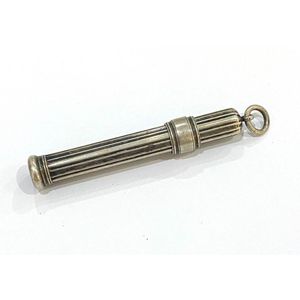
Sterling Silver Pencil Holder, c.1910
A Sampson Mordan & Co sterling silver pencil holder, c.1910, length 7.5 cm
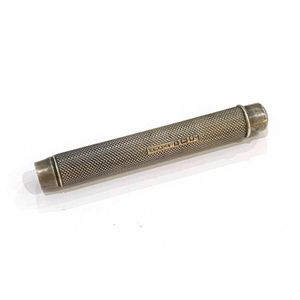
1923 Sterling Silver Pencil Holder with Engine Turned Detail
A Sampson Mordan & Co, sterling silver pencil holder with push button, London, 1923, cross hatch engine turned detail, length 8.5 cm

Sterling Silver Filigree Pencil Holder by Sampson Mordan & Co
A Sampson Mordan & Co, sterling silver pencil holder with Filgree detail, London, length 6.5 cm

Sterling Silver Propelling Pencil by Sampson Mordan & Co
A Sampson Mordan & Co Everpoint sterling silver propelling pencil, London, 1935, length 11 cm

Agate and Gold Propelling Pencil by Sampson Mordan & Co
A Sampson Mordan & Co 15ct yellow gold, agate seat top propelling pencil with reversible cap, filigree detail, engraved initials to agate, length 14 cm

Gold-lined amethyst seal top propelling pencil by Sampson Mordan
A Sampson Mordan & Co, gold lined amethyst seal top propelling pencil, length 8.5 cm

Sampson Mordan 9ct Gold Propelling Pencil, London 1917
A Sampson Mordan & Co Everpoint, 9ct yellow gold propelling pencil, London, 1917, engraved J J Jatt, length 9.5 cm

Sampson Mordan & Co Everpoint 15ct Gold Pencil
A Sampson Mordan & Co Everpoint, 15ct yellow gold propelling pencil, London, 1907, retailed by Hardy Brothers, length 7.5 cm

Sampson Mordan 9ct Gold Propelling Pencil, London 1935
A Sampson Mordan & Co Everpoint, 9ct yellow gold propelling pencil, London, 1935, patent 179005, length 9.5 cm

Turquoise Buttoned Gold Pencil Holder by Sampson Mordan & Co
A Sampson Mordan & Co, 9ct yellow gold pencil holder with turquoise push button, London, 1904, length 7.5 cm

Mordan Everpoint Silver Plated Propelling Pencils - Set of Two
Two Mordan Everpoint silver plated propelling pencils, length 9-11.5 cm

Gold Drop Pencil by Sampson Mordan & Co
9ct gold cased drop pencil hallmarked London 375, maker : Sampson Mordan & Co

Gold Retractable Pencil by S. Mordan & Co
A gold retractable pencil by S. Mordan & Co makers, diamond pattern with retracting slide mechanism with makers stamp to end set with a blood stone, length 10.5 cm, sleeve tests 16ct, with gold plated internal operating section, wt. 11.35g.

Sampson Mordan & Co. 18ct Gold Propelling Pencil
An early 20th century 18ct yellow gold propelling pencil, by Sampson Mordan & Co., pull extension, plain form. 15gm.

ASM Sterling Silver Propelling Pencil with Bloodstone Intaglio
A S Mordan & Co sterling silver propelling pencil with bloodstone intaglio, length 9 cm

Gold Propelling Pencil with Bloodstone Intaglio
A S Mordan & Co 9ct yellow gold propelling pencil with bloodstone intaglio, length 8 cm (closed)

Gold Plated Mechanical Pencil with Stone Inset Decoration
Vintage Sampson Mordan gold plated pencil maker's name marked to mechanical pencil, inset stone decoration to top.

Sampson Mordan Mechanical Pencil with Bloodstone Seal
Sampson Mordan mechanical pencil yellow metal set with a bloodstone seal. Marked S. Mordan & Co makers. Approx length 11 cm
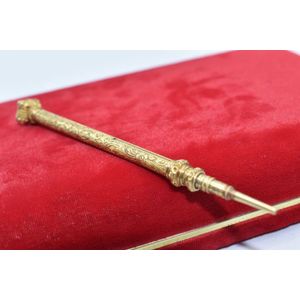
Victorian Bloodstone Propelling Pencil by S. Mordan & Co
Victorian 18ct propelling pencil by makers S. Mordan & Co set with bloodstone (metal core)

Gold Plated Mechanical Pencil by Samuel Mordan
Samuel Mordan gold plated mechanical pencil (length 11 cm approx).

Multi-functional 15ct. gold watch key/propelling pencil/T-bar
An uncommon c.1900 15ct. yellow gold watch key/propelling pencil/T-bar, the t-bar with watch key sliding to one end, propelling pencil to the other, operated from the central toggle. Length 5.2 cm, with maker's stamp 'S. Mordan & Co'.

Mumm Champagne Pencil by Mordan & Co
Rare Mumm & Co. Champagne advertising bottle propelling pencil by Mordan & Co

S. Mordan & Co. Sterling Silver Perpetual Calendar Pencil
An S. Mordan & Co. sterling silver perpetual calendar propelling pencil with citrine finial, rotating day and dates with blue and green enamel detail and citrine finial, propelling stick lever missing, length 10 cm, wt 19 grams

S. Mordan & Co. Gold Propelling Pencils with Hardstone Swivel
Two gold propelling pencils, one with a hardstone set swivel end. Both signed 'S. Mordan & Co.'.
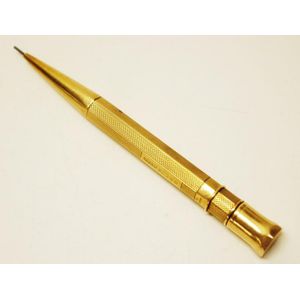
Sampson Mordan 9ct Gold Mechanical Pencil, 1939
Sampson Mordan gold ' Everpoint' pencil mechanical pencil, marked with maker's name, and 9 carat gold stamped, monogrammed and dated 1939,weight 20grams, total.

Mordan 15ct Gold Retractable Pen and Pencil Combo
'Mordan' gold cased Retracting pen and pencil. 15ct cased combination. Width 9.8g, approx

1935 Sterling Silver Mordan Propelling Pencil by Samson Mordan
George V sterling silver Mordan propelling pencil London 1935, maker Samson Mordan.

Antique Guilloche Sterling Silver Pencil by S. Mordan & Co
A 19th century sterling silver antique pencil, guilloche work, pattern by S. Mordan & Co. In fitted box.
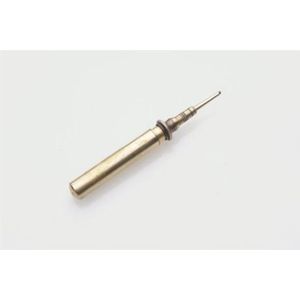
18ct Gold Telescopic Pencil by A.S. Mordan & Co
A S Mordan & Co 18ct yellow gold telescopic pencil, lozenge registration mark, length 4.5 cm Wt 9.2 grams

Sterling Silver Telescopic Pencils, S Mordan & Co
Two sterling silver telescopic pencils including a S Mordan & Co, one with reeded body, hallmarks worn, c1900, the other S Mordan & Co solid seal top, engine turned body, length 4 cm and 4.5 cm

9ct Gold Propelling Pencil by S. Mordan & Co
A S Mordan & Co 9ct yellow gold propelling pencil, length 9 cm Wt 22.5 grams

Sterling Silver Telescopic Bullet Pencil
An S. Mordan & Co. Sterling silver telescopic bullet form pencil, in the form of a bullet, hallmarked sterling silver, inscribed 'Harry shepherd Yakroma' (action loose), length 12 cm

Mordan Silver Mechanical Pencil - Vintage 11cm Length
Vintage Mordan silver mechanical pencil, length 11 cm

Sampson Mordan Gold Propelling Pencil with Extender
Sampson Mordan extending propelling pencil Marked Sampson Mordan 3 to barrel. Approx 65 mm closed, 120 mm extended. Gold sleeved

Mordan's 9ct Gold Sheath Vest Pencil - English Made
A 9ct gold (hallmarked) Mordan's English made sheath vest pencil, retractable, 7 cm long, total weight 7gms

Antique Sterling Silver Telescopic Pencil, London 1909
An S Mordan & Co sterling silver (hallmarked) telescopic pencil, engine turned circular body, London 1909, 9 cm long

9ct Gold Press End Pencil by S Mordan & Co
An S Mordan & Co 9ct gold (hallmarked) press end pencil, 7 cm long, total weight 19gms

Sterling Silver HMV Propelling Pencil with Advertising
An S. Mordan & Co. His Master's Voice advertising propelling pencil, hallmarked sterling silver, marked 'With the compliments of the Gramophone Co. Ltd', 9.5 cm long

S. Mordan & Co. Sterling Silver Engine Turned Pencil (1901)
A sterling silver (hallmarked) S Mordan & Co engine turned press end pencil, inscribed 'J.D.R.', London 1901, 8 cm long
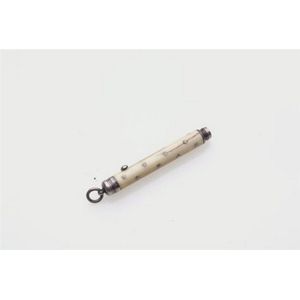
Telescopic Bone Pencil with Star Decorations
An S Mordan & Co telescopic pencil, circular bone body with star decorations, 4.5 cm long

Sterling Silver Telescopic Pencil, 7cm Long
An S Mordan & Co sterling silver (hallmarked) telescopic pencil, hallmarks worn, 7 cm long

1939 Sterling Silver Mordan Everpoint Propelling Pencil with Case
George VI sterling silver Mordan pencil London 1939, makers Mordan & Co, Everpoint propelling pencil, in fitted case.

Telescoping Sterling Silver Pencil with Bloodstone Seal
Sterling silver telescoping pencil by S. Mordan & Co., London, c.1860, with unengraved bloodstone seal end.

Vintage Gold Mechanical Pencil with Bloodstone Finial
Vintage Mordan & Co gold mechanical pencil, Mordan mark to barrel, (gold carat value unmarked, but external barrel tests as 9ct. Internal mechanism untested), bloodstone finial. Monogrammed. Weight 14grams

18ct Gold Sampson Mordan Retractable Pencil (Unmarked)
18ct gold Sampson Mordan retractable pencil, not marked but tests as 18ct gold

S. Mordan & Co. Silver Pencil Holder in Leather Pouch
S.Mordan & Co. Silver pencil holder, in original soft leather pouch, 8.8 cm long (excluding ring)

Sampson & Mordan Gold Pencil with Engraving & Monogram
Sampson & Mordan 18 carat gold retractable pencil with elegant curlicue engraving & decorative finial, engraved S. Mordan & Co makers. & 1888-1938, monogrammed J.M.B to stem & head of finial, weight 75g

Antique Gold Rifle Pencil by S. Mordan & Co
A rare antique gold propelling pencil by S. Mordan & Co., modelled as a rifle, pencil slide concealed under and signed on the top of the barrel, with decorative articulated trigger, styled in 15ct gold, boxed.
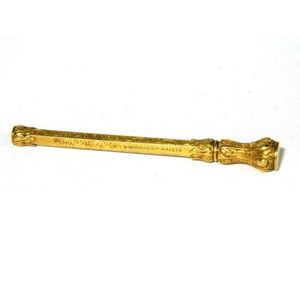
Gilt Mordan & Co Propelling Pencil with Inscription
A gilt Mordan & Co propelling pencil, inscribed ' JMB 1888- 1938

Vintage Gold Writing Set: Mordan, Wahl, and Parker
Two gold filled pencils and a pen, Mordan Everpoint, Wahl Eversharp and Parker

1911 London Hallmarked Silver Pencil Holder by Samson Mordan
Samson Mordan & Co. silver pencil holder, hallmarked London 1911

Victorian Sterling Silver Pencils and Pen Set
Two Victorian sterling silver propelling pencils and pen, foliate and Corinthian column design and stone set. One fully marked with Sampson & Mordan marks Victorian, 40g (2)

S. Mordan 9ct Gold Mechanical Pencil with Engine Turned Design
Vintage S.Mordan gold mechanical pencil engine turned decoration. 9ct yellow gold, London hall mark.

Sterling Silver Pencils by Samson Mordan, 1880
Two sterling silver pencils, Samson Mordan, circa 1880.

Antique Sterling Silver Pencils by Mordan and London
A sterling silver pencil, Sampson Mordan, London 1900, and one other.

Antique 15ct Gold Propelling Pencil by S. Mordan & Co
An antique gold propelling pencil, S. Mordan & Co. Birmingham. 15ct yellow gold. Weight 25.51 grams. Compressed length 7 cm.

Sampson Mordan Sterling Silver Writing Set
Sampson Mordan sterling silver writing set comprising of a lead projecting pencil and pen, both marked S. MORDAN STERLING, 14 cm long approx
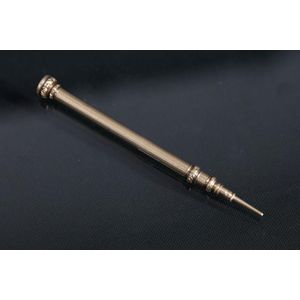
Sampson Mordan 9ct Gold Pencil with Seal
9ct yellow gold Sampson Mordan pencil. Metal mechanism. Seal to top.

Victorian Silver Letter Opener with Pencil
A late-Victorian silver letter opener/with propelling pencil; Sampson Mordan & Co., London 1898. Length 18 cm. (fitted case)

Silver Propelling Pencils by Mordan and Raker & Sons
S. Mordan silver propelling pencil & another by E. Raker & Sons

Engraved Sterling Silver Pencil with Family Crest
Hallmarked sterling silver pencil, S. Mordan & Co London 1919-20, engraved with a family crest

Gold Pencils from Dame Nellie Melba's Collection
A 9ct gold pencil, Sampson Mordan & Co., London 1920 (2). A 9ct gold pencil, Sampson Mordan & Co., London 1920 the plain pencil with removable lid, loop to opposite end, inscribed to the exterior Dame Nellie Melba 1925, 7 grams, 75 mm long (2). Property…

Silver Drop-Action Pencil by Sampson Mordan (1913)
A silver drop-action pencil; Sampson Mordan, Chester 1913. (pencil non-extant)
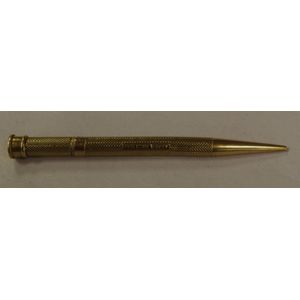
London Hallmarked 9ct Gold Mordan Mechanical Pencil
9ct gold Mordan mechanical pencil, hallmarked London
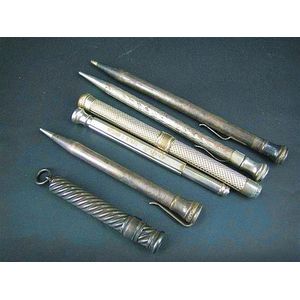
Rare Collection: Pencils by Sampson Mordan and More
Six pencils including one by Sampson Mordan. (6)

Gold Mechanical Pencil by Sampson Mordan & Co
A gold-cased mechanical pencil; Sampson Mordan & Co. retailed by Webster, Piccadilly

Sterling Silver Retractable Pencil by S. Mordan & Co
S. Mordan sterling silver retractable pencil hallmarked Chester,stamped S. Mordan & Co, H. Brs, 9.4 cm long approx



 Loading more...
Loading more...